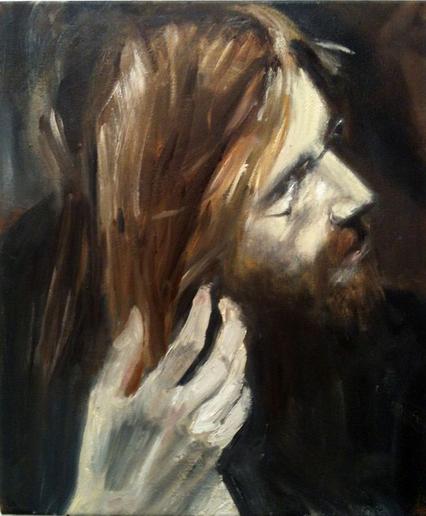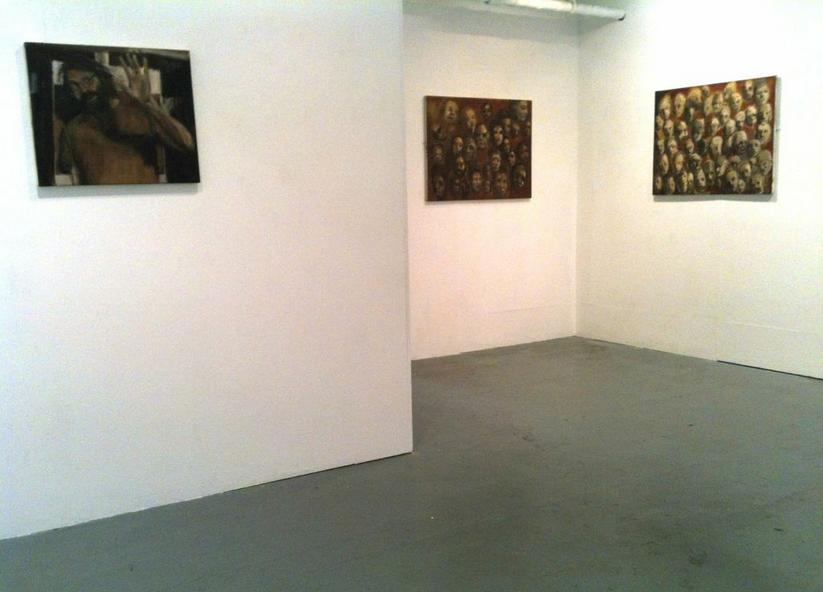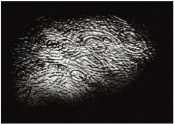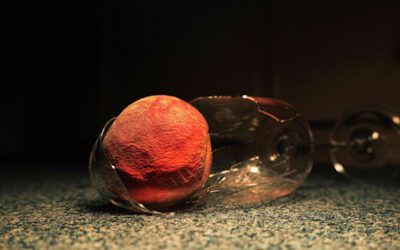[dropcap style=”font-size:100px; color:#992211;”]“We[/dropcap]should consider every day lost in which we do not dance at least once.”
– Friedrich Nietzche
SUPERPAINTINGS at Transition Gallery features ten new works made in collaboration, for the first time, by two old friends who met at art school in the late 1990s.
The friendship began with a shared sense of humour, a love of old-master paintings and a tendency for late night disco dancing. This most recent partnership harnesses these traits to produce studies that re-enact dance moves from the 1981 cult hit song ‘Superman’ by Black Lace.
In addition, through the use of cutting edge technology, the artists have added a further augmented dimension to the painterly discourse. The history of each painting can be viewed in the gallery by holding a mobile device to the subject of the work thus unfolding the life and process of the artwork.
The show coincides with Issue XV of Transition Gallery’s magazine Garageland entitled ‘Collaboration.
There is something about conceptualism, which can release something of a bipolar in me. On the one hand, my pseudo-intellectual self yearns to dig beneath the surface and to research the critical background of the work to death, in order to match any convolutions of the press release with my own assumed superiority.
It is this self that often vehemently jumps to defend work that I aesthetically loath, when people outside of the art world rile at dinner parties about conceptual art being fraudulent. Anything to keep the heckles up.
But then there’s the kernel within me that will always admire a ‘nice’ painting, revels in craftsmanship and yearns to interpret the work based on my own engagement with it.
Unfortunately the proliferation of social media, press and even ‘arty’ chat generally mean that a complete de-contextualisation is unachievable.
SUPERPAINTINGS is based around a concept. A concept of mimesis and multiplicity- retranslating the dance moves of the Black Lace song ‘Superman’ through the acts of collaborative painting and the augmented reality of technology.
Collaboration is nothing new, evident in the recent exhibition The Bride and the Bachelors at the Barbican, which showcased the interweaving lives and joint works of those such as Duchamp and John Cage. Maybe this too was a comment on universality?
I scoured the press release again.
A phrase which stuck out was:
‘As society suffers cuts from ‘tightening of the belt’ austerity measures, one has to remember that, maybe, in the bigger picture Nietzsche and Black Lace were right after all.’
Hook line and sinker my pseudo intellectual brain kicked in and seized upon this and the juxtaposition of the title of the show ‘SUPERPAINTINGS – ÜBERKUNST’. It promptly overrode my more playful and romantic imaginative engagement with the work and decided to focus upon philosophical context- determined to show it who was boss.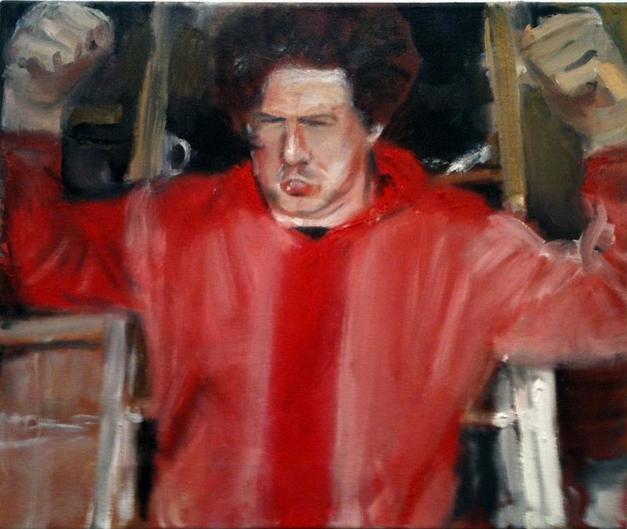
I dutifully re-familiarised myself with Nietchze’s theories of ‘Übermensch’ (the superhuman) and, armed with this smug prior knowledge read the show thus…
‘The first thing that strikes the viewer is the old masterly quality of the paintings which, depict male subjects in various poses borrowed from Black Lace’s ‘Superman’. Even without the prior knowledge of the conceptual element of the show then, the paintings are beautifully rendered in a dark autumnal palette, resonating with a sense of antiquity. The conceptual ventriloquism has clearly not come at the expense of the fact that this is very much a painterly interpretation.
Pieces such ‘Comb your hair’ and ‘Sleep Sleep’ in particular, are reminiscent of religious devotional gestures which, coupled with the apparitional appearance of the figures from the dark backgrounds, creates a haunting atmosphere of reverence. In addition, the simple hanging of the works, well spaced along the stark whiteness of the gallery, heightens this sensation of sanctity.
A surreal dialogue is therefore established between the beauty of the paint and aura of the installation- which one must stop to savour- and the frivolity of the Pop Culture references to ‘Superman’. The low culture link immediately derails the original sense of Übermensch.
Perhaps then an exhibition about artifice? Our aspirational society, whose consumerism and striving towards alpha male status has led to times of austerity, somehow becomes laughable in the bathetic contrast between high and low culture.’
I found myself almost looking forward to the REALLY meta part of the exhibition with the jazzy augmented reality, so that I could quip about how all of our past and future experience has become part of noise of the ‘Now’.
It was however, this notion of derailment and, that phrase in the literature that ‘Both Nietchze and Black Lace were right’ that something was afoot that wasn’t exclusively based upon a philosophical reflection of high art versus low.
From this moment I realised that I’d been hankering a little too much after the notion of art as play, rescued through Nietzche. In doing so I had failed to shift my attention to the word ‘play’ and to the introductory biography of the artists as ‘sharing a sense of humour’.
Did I really give a crap about the Pop Culture references and reinterpretation through Nietzche? Viewing the work with the technological addition, I realised that the answer was No, I was having too much FUN.
As well as animating the figures, the phone app demanded that we re-examine the paintings with the process of the collaboration and the friendship and humour of the artists in mind. Exposed was the word that came to mind and, it wasn’t just the exposure of painting process- it was an exposure of the actual concept.
As Corinna Spencer who interviewed James and Oliver for the ‘Collaboration’ issue of Garageland notes:
‘What I found from the interview was that they shared their skills freely with each other and worked on a canvas together, taking frequent turns (one would paint while the other carried out other tasks such as research and organising the space).
This close relationship and shared interests along with the pooling of skills and the constant quest for the new seems to have kept this collaboration fresh.’
In the electronic re-examination I also noticed the glint in some of the subject’s eyes, a certain mischievous knowingness and over exaggeration in posture which, combined with the fluidity of brush marks seem to cry out to be animated- to engage in the FUN part of the show.
[quote]Collaboration can be
fun, Conceptualism can
be fun and, in
this case, there
was a direct
invitation to the
viewer to join in
the rumpus.
Connelly and Bancroft
are laughing, the
question is are
we laughing too?[/quote]
Fun, yes, Fun- but for whom? My laughter was becoming somewhat uncomfortable. The hallucinatory, frantic gestures of the freshly animated subjects hinted at something sinister under the frivolity. With repetition, the dance moves became akin to a particularly bad ecstasy trip where everything morphs into a repetitious blur of whirlwind movement. You know you’re having a good time but something in your cognitive mind nags that you’re not quite sure why.
Although I was no longer associating the aesthetic proficiency of the paintings with some grand philosophical dogma, there were hints here of Nietzche’s concept of the ‘eternal return’- of having to accept our history of flaws and weaknesses in order to truly progress.
Like their predecessors of Johns and Rauschenburg these were two artists in a state of play, having a hoot and making jokes as they also learnt from each other.
The laughter however, I came to realise, was directed at the viewer. It dawns on us that we are mocking ourselves and our banal aspirations to be ‘super humans’ in the modern age- an equally liberating but also disconcerting experience.
This darkly comic state of play is noted by the show’s curator Mimei Thompson:
‘The two share a distinctive sense of humour which is reflected in the linking of Nietzche to Black Lace through Superman- it reeks of the absurd.
The result is a self-contained world, a product of them both together. This is evident in one of my personal highlights form the show, ‘Comb your Hair’- it feels kind of religious but also mundane, with an underlying humour.
It was this aspect that actually made Cathy (Lomax) decide to do the ‘Collaboration’ issue of GarageLand.’
So yes this was an exhibition where the context was imperative to the work, however, what I had originally missed was that the concept was in the collaborative process itself- how we need each other, how it is possible to have no rules- that self -mockery is something we should all have a healthy dose of once in a while.
Yes Nietzche and Black Lace were both right. Sometimes we simply need to ‘dance’- knowing that we’re not Supermen.
Collaboration can be fun, Conceptualism can be fun and, in this case, there was a direct invitation to the viewer to join in the rumpus. Connelly and Bancroft are laughing, the question is are we laughing too?
‘SUPERPAINTINGS’ runs until the 9th June at Transition Gallery
It is one of a series of shows at Transition that examine ideas around collaboration. For more on this see: Garageland 15: Collaboration which features an interview with Oliver Bancroft and James Connolly by Corinna Spencer

